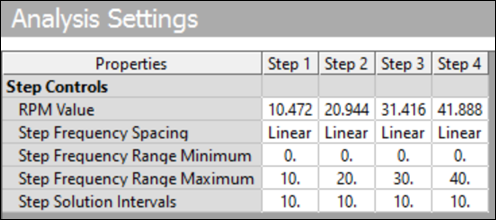Multiharmonic combination results expose two objects.
Multiharmonic Plot and Chart provide the composite values of all harmonic responses at different frequencies in the time domain. The composition of harmonic responses excited at different frequencies into a time domain signal is done as follows:

To compose such a signal, the fundamental frequency must be established.
If a solution exists, the solution is periodic and ω0 (the greatest common divisor of all frequencies) is the fundamental frequency. If a solution does not exist, the signal is not periodic.
The Multiharmonic Plot and Chart objects assume that all loadings are multiples of a greatest common divisor. Signals are assumed to be periodic, both inputs and outputs of the multiharmonic analysis.
Multiharmonic combination objects are only valid if the solution intervals are equal in all RPMs/Steps.
For derived results like Von Mises stress, the values are first converted to the time domain before composition.
Explanation of calculations performed
Calculation of engine orders
As an example, a multiharmonic analysis can be conducted with the steps defined as shown.

Here,
Engine Orders = Maximum Frequency value in each step / GCD
Where GCD is the greatest common divisor of the maximum frequency value in each step.
In this specific case:
Engine Orders = [10, 20, 30, 40] / 10
Engine Order = [1, 2, 3, 4]
Calculation of harmonic composite response
DPF operators are used to obtain the result data at each solution interval in each defined step (RPM value). Another DPF operator
fft_multi_harmonic_minmaxis used to create a composite of the harmonic response. For more details on this refer to thefft_multi_harmonic_minmaxoperator in the appropriate Data Processing Framework (DPF) manual.


